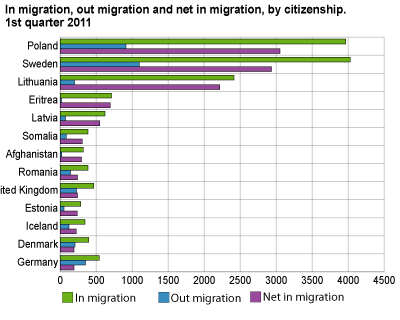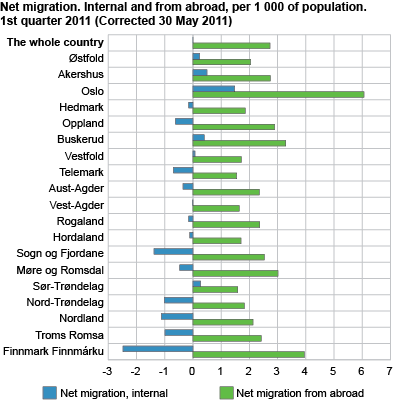Content
Published:
This is an archived release.
Rapidly heading for 5 million
Norway's population increased by 17 000 to 4 937 000 in the first quarter of 2011. If the increase continues on the same level, at some point between February and April next year the population will reach five million.
The population increase in the first quarter was 2 000 higher than last year. If the increase continues at the same level as in 2010, the population will reach five million in April, but should the rate of increase seen in the first quarter continue throughout the rest of 2011, it could happen as early as February. April, though, is the most probable month.
The immigration surplus from abroad made up four fifths of the population increase
Immigration totalled 22 300 in the first quarter; 3 200 more than last year, and the highest number ever recorded in a first quarter. A total of 8 900 persons emigrated, and this was also the highest number ever recorded. Thus, the resulting net migration of 13 400 was the highest ever. During the 1990-2007 period it varied from 100 to 7 500.
A total of 14 400 children were born, reaching the same level as the years since 1988. A total of 10 800 died, and with the exception of 2006, this was the lowest number of any first quarter since 1984. Although the resulting birth surplus of 3 500 was lower than last year, it was still higher than the average for the period from 1988.
Increase from Poland, Lithuania and Sweden
Of immigrants having other citizenship than Norwegian, almost eight out of ten had a European citizenship. Almost half of these; 7 300, came from Poland or the Baltic countries. Immigration from Poland and Lithuania increased, whereas the number of Latvians decreased and Estonians remained at the same level. Since the emigration of Polish citizens dropped, their net in migration increased from 1 900 to 3 050.
The number of Swedish citizens arriving increased the most and reached 4 000; up 1 500 from last year. The number this year was particularly high, partly because some 1 000 more Swedes were registered in January this year compared to last year in connection with changed routines for receipt of tax cards.
Citizens of countries where flight is an important reason for emigration are registered as immigrants when they receive their residency permit. The number of refugees arriving is therefore not directly comparable to the number of immigrants. Immigration among Eritrean citizens almost doubled and reached 700. Immigration among Somali citizens decreased, but remained stable among Afghan citizens, each of these reaching 300.
Population increase in all counties, but to a varying degree
Two counties - Oslo and Akershus - had a combined population increase of 8 100; almost half the total growth of Norway. Rogaland and Hordaland had a combined growth of 3 000, down 1 400 from last year. The two counties Telemark and Finnmark had the smallest growth, with 100 each.
Highest natural increase in Oslo
Oslo also stood out as regards excess of births over deaths in the first quarter of 2011, which reached 1 300; more than a third of the total excess of births in the country. Five counties had a deficit of births over deaths. Fifteen of the 19 counties saw poorer net figures than last year.
Migration gain from abroad in all counties
All counties had a migration gain from abroad. The two counties Oslo and Akershus had a total gain of 5 100, up 2 000 from last year. In Rogaland and Hordaland the combined gain was 1 900, down 1 000 from 2010. The migration gain totalled 13 400 and offset the birth deficit and domestic migration loss in many counties.
Thirteen counties had a domestic migration loss, whereas six had a domestic migration gain, the largest of which were in Oslo and Akershus. These two counties had a gain of 900 and 300 respectively, whereas the remaining four counties had a combined gain of 250.
Population increase in 269 municipalities
A total of 269 of the 430 municipalities had a population increase in the first quarter, whereas 149 had a decrease and 12 saw no change. As in previous years, the population increased in centrally situated municipalities whereas less central areas experienced migration loss and birth deficit. Half of the 20 municipalities with the largest birth surplus were situated in Rogaland and Hordaland.
| Total migration gain (276 in all) | Domestic migration gain (156 in all) | Migration gain from abroad (381 in all) | |||||||||||||||||||||||||||||||||||||||||||||||||||||||||||||||||||||||||||||
|---|---|---|---|---|---|---|---|---|---|---|---|---|---|---|---|---|---|---|---|---|---|---|---|---|---|---|---|---|---|---|---|---|---|---|---|---|---|---|---|---|---|---|---|---|---|---|---|---|---|---|---|---|---|---|---|---|---|---|---|---|---|---|---|---|---|---|---|---|---|---|---|---|---|---|---|---|---|---|---|
| 1 | Oslo | 4 524 | Oslo | 886 | Oslo | 1 914 | |||||||||||||||||||||||||||||||||||||||||||||||||||||||||||||||||||||||||
| 2 | Bergen | 607 | Trondheim | 195 | Bergen | 792 | |||||||||||||||||||||||||||||||||||||||||||||||||||||||||||||||||||||||||
| 3 | Trondheim | 454 | Tønsberg | 129 | Stavanger | 640 | |||||||||||||||||||||||||||||||||||||||||||||||||||||||||||||||||||||||||
| 4 | Bærum | 350 | Bergen | 125 | Sandnes | 271 | |||||||||||||||||||||||||||||||||||||||||||||||||||||||||||||||||||||||||
| 5 | Tromsø | 252 | Hamar | 91 | Trondheim | 207 | |||||||||||||||||||||||||||||||||||||||||||||||||||||||||||||||||||||||||
| 6 | Tønsberg | 243 | Tromsø | 89 | ålesund | 183 | |||||||||||||||||||||||||||||||||||||||||||||||||||||||||||||||||||||||||
| 7 | ålesund | 236 | Sola | 81 | Kristiansand | 181 | |||||||||||||||||||||||||||||||||||||||||||||||||||||||||||||||||||||||||
| 8 | Stavanger | 212 | Sørum | 80 | Drammen | 174 | |||||||||||||||||||||||||||||||||||||||||||||||||||||||||||||||||||||||||
| 9 | Ullensaker | 196 | Sandefjord | 73 | Tromsø | 169 | |||||||||||||||||||||||||||||||||||||||||||||||||||||||||||||||||||||||||
| 10 | Fredrikstad | 182 | øvre Eiker and Lier | 70 | Asker | 153 | |||||||||||||||||||||||||||||||||||||||||||||||||||||||||||||||||||||||||
| Total migration loss (143 in all) | Domestic migration loss (265 in all) | Migration loss to abroad (30 in all) | |||||||||||||||||||||||||||||||||||||||||||||||||||||||||||||||||||||||||||||
| Nøtterøy and Sauherad | -20 | Larvik and Kristiansund | -44 | Six municipalities | -1 | ||||||||||||||||||||||||||||||||||||||||||||||||||||||||||||||||||||||||||
| Høyanger, Fauske, Karlsøy and Lyngen | -21 | Sunndal | -47 | Seven municipalities | -2 | ||||||||||||||||||||||||||||||||||||||||||||||||||||||||||||||||||||||||||
| Sunndal | -23 | ås | -48 | Five municipalities | -3 | ||||||||||||||||||||||||||||||||||||||||||||||||||||||||||||||||||||||||||
| Leirfjord | -24 | Voss | -50 | Vaksdal and Austrheim | -4 | ||||||||||||||||||||||||||||||||||||||||||||||||||||||||||||||||||||||||||
| Holmestrand, Verdal and Bø (Nordland) | -26 | Alta | -51 | Aremark, Etne and Værøy | -5 | ||||||||||||||||||||||||||||||||||||||||||||||||||||||||||||||||||||||||||
| Kvæfjord | -27 | Haugesund | -55 | Gjemnes | -6 | ||||||||||||||||||||||||||||||||||||||||||||||||||||||||||||||||||||||||||
| Nordreisa | -28 | Malvik | -61 | Herøy and Verran | -7 | ||||||||||||||||||||||||||||||||||||||||||||||||||||||||||||||||||||||||||
| Ulstein | -31 | Ringerike | -62 | Stange and Leirfjord | -9 | ||||||||||||||||||||||||||||||||||||||||||||||||||||||||||||||||||||||||||
| Fjaler | -35 | Nittedal | -73 | Bø (Nordland) | -14 | ||||||||||||||||||||||||||||||||||||||||||||||||||||||||||||||||||||||||||
| Malvik | -40 | Stavanger | -149 | Fjaler | -32 | ||||||||||||||||||||||||||||||||||||||||||||||||||||||||||||||||||||||||||
| Excess of births (196 in total) |
Excess of births in relation to population/
1 000 (196 in total) (Norway = 0.7) |
Population growth (269 in total) |
Population growth in relation to population/
1 000 (269 in total) (Norway = 3.4) |
||||||||||||||||||||||||||||||||||||||||||||||||||||||||||||||||||||||||||||
|---|---|---|---|---|---|---|---|---|---|---|---|---|---|---|---|---|---|---|---|---|---|---|---|---|---|---|---|---|---|---|---|---|---|---|---|---|---|---|---|---|---|---|---|---|---|---|---|---|---|---|---|---|---|---|---|---|---|---|---|---|---|---|---|---|---|---|---|---|---|---|---|---|---|---|---|---|---|---|---|
| 1 | Oslo | 1 259 | Hemsedal | 4.2 | Oslo | 5 783 | Modalen | 32.4 | |||||||||||||||||||||||||||||||||||||||||||||||||||||||||||||||||||||||
| 2 | Bergen | 312 | Bjerkreim | 3.4 | Bergen | 919 | Hemsedal (Buskerud) | 22.4 | |||||||||||||||||||||||||||||||||||||||||||||||||||||||||||||||||||||||
| 3 | Stavanger | 236 | Sveio | 3.3 | Trondheim | 675 | Flå (Buskerud) | 19.0 | |||||||||||||||||||||||||||||||||||||||||||||||||||||||||||||||||||||||
| 4 | Trondheim | 221 | Osen | 2.9 | Stavanger | 448 | ørskog | 14.6 | |||||||||||||||||||||||||||||||||||||||||||||||||||||||||||||||||||||||
| 5 | Tromsø | 136 | Førde | 2.9 | Bærum | 433 | Balestrand | 12.7 | |||||||||||||||||||||||||||||||||||||||||||||||||||||||||||||||||||||||
| 6 | Sandnes | 119 | Etne | 2.8 | Tromsø | 388 | Hole (Buskerud) | 12.1 | |||||||||||||||||||||||||||||||||||||||||||||||||||||||||||||||||||||||
| 7 | Kristiansand | 93 | Bardu | 2.8 | ålesund | 280 | Osen | 11.7 | |||||||||||||||||||||||||||||||||||||||||||||||||||||||||||||||||||||||
| 8 | Bærum | 83 | øksnes | 2.7 | Ullensaker | 249 | Gol (Buskerud) | 10.3 | |||||||||||||||||||||||||||||||||||||||||||||||||||||||||||||||||||||||
| 9 | Sola and Askøy | 63 | Modalen and Sola | 2.7 | Tønsberg | 248 | øksnes | 9.7 | |||||||||||||||||||||||||||||||||||||||||||||||||||||||||||||||||||||||
| 10 | Bodø | 58 | Hå | 2.7 | Drammen | 224 | Ullensvang | 9.7 | |||||||||||||||||||||||||||||||||||||||||||||||||||||||||||||||||||||||
| Birth deficit (214 in total) |
Birth deficit in relation to population/
1 000 (214 in total) |
Population decrease (149 in total) |
Population decrease in relation to population/
1 000 (149 in total) |
||||||||||||||||||||||||||||||||||||||||||||||||||||||||||||||||||||||||||||
| Røros | -13 | Tolga | -4.8 | Five municipalities | -25 | Leka | -10.2 | ||||||||||||||||||||||||||||||||||||||||||||||||||||||||||||||||||||||||
| åmot, Jevnaker and Hammerfest | -14 | Ibestad and Mosvik | -4.9 | Holmestrand and Malvik | -26 | Kvæfjord | -10.5 | ||||||||||||||||||||||||||||||||||||||||||||||||||||||||||||||||||||||||
| Kongsvinger, Grue and Farsund | -15 | Tjeldsund | -5.3 | Høyanger | -27 | Leirfjord | -11.6 | ||||||||||||||||||||||||||||||||||||||||||||||||||||||||||||||||||||||||
| Halden and Vågå | -16 | Bø (Nordland) | -5.7 | Søndre Land | -28 | Fjaler | -12.4 | ||||||||||||||||||||||||||||||||||||||||||||||||||||||||||||||||||||||||
| Vestre Toten and Bø (Nordland) | -16 | Vevelstad | -5.8 | Ulstein | -30 | Valle | -12.5 | ||||||||||||||||||||||||||||||||||||||||||||||||||||||||||||||||||||||||
| Rygge and åsnes | -17 | Folldal | -6.0 | Nordreisa | -31 | Fosnes | -13.8 | ||||||||||||||||||||||||||||||||||||||||||||||||||||||||||||||||||||||||
| Søndre Land and Porsgrunn | -17 | Vega | -6.3 | Kvæfjord | -32 | Beiarn | -14.5 | ||||||||||||||||||||||||||||||||||||||||||||||||||||||||||||||||||||||||
| Ringsaker | -19 | Valle | -7.0 | Verdal | -34 | Bø (Nordland) | -15.1 | ||||||||||||||||||||||||||||||||||||||||||||||||||||||||||||||||||||||||
| Nøtterøy | -22 | Loppa | -7.4 | Fjaler | -36 | Bjerkreim | -15.2 | ||||||||||||||||||||||||||||||||||||||||||||||||||||||||||||||||||||||||
| Hamar and Gjøvik | -30 | Hasvik | -8.2 | Nøtterøy and Bø (Nordland) | -42 | Bjarkøy | -16.8 | ||||||||||||||||||||||||||||||||||||||||||||||||||||||||||||||||||||||||
One million, two million, three ...Not until 1822 did Norway reach one million inhabitants. In 1890, 68 years later, the two million mark was reached. The third was reached 52 years after this, in 1942. Then in 1975, after 33 years, the fourth was reached. The fifth will be reached in 2012, after 37 years. The largest population increase ever was seen in 2010, with 62 100. On the other hand, the year 1741 saw the largest decrease; 12 700 or two per cent. |
The statistics is published with Population.
Contact
-
Statistics Norway's Information Centre
E-mail: informasjon@ssb.no
tel.: (+47) 21 09 46 42



